Posted by Elena del Valle on January 11, 2012
By Alex Zylberglait
Vice president, Investments
Miami office of Marcus & Millichap

Alex Zylberglait, vice president, Investments, Marcus & Millichap
Photo: Alex Zylberglait
A 1031 exchange, otherwise known as a tax deferred exchange is a simple strategy and method for selling one property, that’s qualified, and then proceeding with an acquisition of another property (also qualified) within a specific time frame. The logistics and process of selling a property and then buying another property are practically identical to any standardized sale and buying situation, a “1031 exchange” is unique because the entire transaction is treated as an exchange and not just as a simple sale. It is this difference between “exchanging” and not simply buying and selling which, in the end, allows the taxpayer(s) to qualify for a deferred gain treatment. So to say it in simple terms, sales are taxable with the IRS and 1031 exchanges are not. US CODE: Title 26, §1031. Exchange of Property Held for Productive Use or Investment.
Click here to read the complete article 1031 exchanges as a commercial real estate investment strategy
Posted by Elena del Valle on January 9, 2012
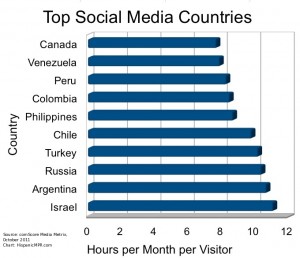
Top Social Media Countries – click to enlarge
In many countries social networking has become ubiquitous. The mode of communication has become an essential part of people’s daily lives. Traversing international boundaries social networking has turned into the most popular online activity, according to It’s A Social World Top 10 Need-to-Knows About Social Networking and Where It’s Headed, a December 2011 comScore report. ComScore tracks online behavior and usage.
In October 2011, comScore researchers estimate social networking accounted for 19 percent of people’s time online or nearly 1 in every 5 minutes spent online; and social media, they believe, reaches 82 percent of the world’s 1.2 billion internet population.
Where people used to send emails and use instant messaging software to communicate many now rely on social media, the report says. In the United States (98 percent) and Canada (94 percent) social media site penetration, comScore staff believe, is nearly pervasive. They also estimate 41 of the 43 markets individually reported by comScore exhibit a market penetration of 85 percent or more.
When the researchers examined total time spent online, Israel was the most active country, followed by Argentina, Russia, Turkey, Chile, Philippines, Colombia, Peru, Venezuela and Canada. People in the Asia Pacific region, particularly East Asian countries, spend the least amount of time on social networks, according to the comScore findings.
The report also indicates women spend more time social networking than men. For example, women in North America and Europe, spent an average of nearly two hours (30 percent) more than men on social networking sites in a month. Older adults, users 55 and older, are the fastest growing segment in social networking sites, says the report.
Facebook is the undisputed leader in most countries. In October, Facebook reached 55 percent of the world’s audience, accounting for about three in every four minutes people spent on social networking sites and one in every seven minutes they spent online per comScore data.
Microblogging, mainly Twitter, is booming worldwide. Twitter reaches one in ten internet users around the planet to rank among the top social networks. In the last year it grew 59 percent. While initially users in the United States drove social media and microblogging growth that is no longer true. Only 19.8 percent of Facebook users, 20 percent of Twitter fans, and 38.2 percent of LinkedIn users are in the United States.
Posted by Elena del Valle on January 6, 2012
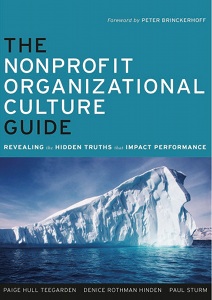
The Nonprofit Organizational Culture Guide book cover
Photos: Josey-Bass, Greg Shaler, Paige Hull Teegarden, Paul Sturm
What people say and what they do are often in conflict and so it is with the organizations where they work and that they run. Companies and organizations, like people, may unwittingly send mixed messages. One organization may tout its democratic and equitable approach toward its members while exhibiting a clearly discriminating pattern of employment toward its staff, for example.
The often unwritten organizational culture sets the tone within an organization and dictates informally the direction it takes and its parameters. Each company or organization has its own unique culture. There is, according to some experts, no single culture that is the best for everyone. On the other hand, it is important when dealing with any organization or company to be aware of and understand its culture. And, for profit and nonprofit entities are different by their very nature.

Paige Hull Teegarden, M.P.P.
There are about two million nonprofit organizations employing as many as eleven million people in the country. Although many assumptions can be made about the characteristics of a nonprofit entity often there are no clear definitions about its organizational culture. In The Nonprofit Organizational Culture Guide Revealing the Hidden Truths that Impact Performance (Josey-Bass, $40), Paige Hull Teegarden, M.P.P., Denice Rothman Hinden, Ph.D., A.C.C., and Paul Sturm, M.P.A., M.S. outline their thoughts on the topic for an audience of nonprofit leaders, managers, educators, funders and anyone seeking to understand the nonprofit sector and its effectiveness. The book required seven years of work and two publishers (the first one went out of business before publishing the book) before becoming available in December 2010.
The authors believe understanding the culture of an organization is an ongoing process that may assist those who work in or interact with the organization to be effective in orienting new staff and board members, identify leaders, define the organization’s change parameters, develop matching strategies, communicate and market with success, and find appropriate restructuring or merger choices.
“There were three big challenges. One was our inability to get financial support early on to support our research. Folks just weren’t convinced that we could reveal something that you can’t see. The second challenge was losing our publisher just before the book was going into production. The third challenge was keeping up the energy of all three authors to get the book out after seven years of trials,” said Rothman Hinden in response to a question about the biggest challenges they faced.
“Building upon the previous research and literature about organizational culture in a way that would be useful to nonprofit organizations. Prior to our book, virtually all the work and references about organizational culture had been focused on for-profit corporations,” said Sturm in response to the same question.

Denice Rothman Hinden, Ph.D., A.C.C.
The 174-page softcover book is divided into five chapters: Nonprofit Culture, Six Examples of Nonprofit Culture in Action, Revealing Organizational Culture, Reflections on Organizational Culture, and Recommendations for Nonprofit Leaders and Capacity Builders; and three appendices: Sector Informants, Organizational Culture Diagnostic Tools and About Mind Maps and Mind Mapping.
The authors propose four phases toward revealing the organizational culture process: Preparing by establishing a basic understanding of the organization and its context; identifying the organization’s objectives by finding culture stories and understanding their meaning; studying how the organization’s culture may affect the organization in achieving its objectives and developing a plan of action; and examining the ways in which change takes place within the organization in order to implement a plan.
“The encouragement and feedback we’ve received from thought-leaders and others committed to enhancing the effectiveness of nonprofit organizations and the nonprofit sector,” said Sturm when asked about the most rewarding aspect of collaborating in the book.
“Most rewarding has been demonstrating to organization leaders that there is great value in paying attention to what you can’t easily see in organizations. The book is a call to action to leaders to think about organizational experiences in a different way, and to use what they learn to create more effective management and program strategies. Helping nonprofit organization leaders think intentionally about the hidden elements of organizational culture is an important new step for strengthening organization performance,” said Rothman Hinden.

Paul Sturm, M.P.A., M.S.
Hull Teegarden, president, Think Outside, is a systems thinker with more than 15 years of experience. Rothman Hinden*, president, Managance Consulting & Coaching, has more than 25 years of nonprofit management experience. Sturm, a 25-year specialist in nonprofit leadership development and capacity building, teaches at the University of Baltimore and the College of Notre Dame of Maryland.
* The author of this note and Denice Rothman Hinden have been friends for many years.
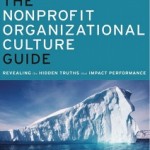
Click to buy The Nonprofit Organizational Culture Guide
Comments:
Filed Under: Books
Posted by Elena del Valle on January 4, 2012

Photo: Hulu Latino
Hulu, an online portal offering ad supported video content from NBC, Fox, ABC, CBS, and Nickelodeon among others, decided recently to target Spanish speakers in the United States with a new channel, Hulu Latino (hulu.com/latino). Content for the new portal, only available domestically, is provided and selected by eleven companies: Azteca America, Butaca, Caracol Televisión, Comarex, Estrella TV, Imagina US, Laguna Productions, Maya Entertainment, RCTV, Todobebe Inc, and Venevision.
Hulu staff hope to capture the under served market segments of the video watching Hispanic market. They believe that, based on Nielsen data, 78 percent of that segment is bilingual. A spokesperson explained by email that promotion of the new channel will be the responsibility of its content partners. She declined to identify Hulu audience numbers, the exact target audience for the new portal or the exact number of Spanish language videos on offer.
She responded by email saying “The portal launched with hundreds of hours of Spanish-language film and TV shows on Hulu and Hulu Plus;” and “Hulu does not break out specific viewership information, but what we can say is that we are very excited about the new audiences we expect to serve with this content.”
According to an article in the Los Angeles Times (Hulu launches Latino service with Spanish-language programming) December 13, 2011 there are five Hulu Latino sponsors, Corona, Modelo, Toyota, Pantene, and Volkswagen of America.
NBCUniversal (Comcast/General Electric), News Corporation, The Walt Disney Company and Providence Equity Partners (owner of Newport Television) own Hulu. Founded in March 2007, Hulu has offices in Los Angeles, New York, Chicago, Seattle, Tokyo and Beijing.
Posted by Elena del Valle on January 3, 2012

As we start another year we are thankful for the years passed and for you our readers and listeners of the HispanicMPR articles and podcast interviews.
We wish you a very healthy, happy and prosperous New Year!
Posted by Elena del Valle on December 16, 2011

Emanuel Andren’s Monte Enebro chocolate
Photo: Emanuel Andren, Mars, Elizabeth Arden, Edward Marc Chocolatier
More consumers (13 percent) regard cell phones as appropriate gifts for children ages 6 to 11, up from 4 percent earlier this year. About one in three (32 percent) shoppers expect stores to offer boxes although at the same time 21 percent of survey takers said they don’t bother with wrapping paper relying instead on gift bags. More than 20 percent prefer to browse the stores then shop online to save money. A similar number say they plan to reduce the number of people they gift. These estimates are based on the 25 Stocking Stuffers from Mintel, Holiday Shopping U.S. July 2011 and Seasonal Chocolate U.S. August 2011 Mintel survey reports.
On the positive front, 27 percent of survey respondents said that when they shop for the holidays, they often buy something for themselves. Christmas decorations and cards remain popular; 42 percent of survey takers said they bought Christmas decorations in the past year while 64 percent bought a Christmas card and 67 percent received one in the past year. Even pets were involved; 11 percent of respondents said pets sent a card or gift.

White Diamonds Elizabeth Taylor Holiday Gift Set, for those who wish to wear or gift the top selling celebrity fragrance
Many (29 percent) of domestic consumers said they bought someone a fragrance and 28 percent bought candles for Christmas. That’s not surprising since winter holidays have been the high season for fragrance sales in past years, according to Mintel.
Celebrity endorsed fragrances are among the most popular, according to a Forbes.com April 2011 article (Top-Selling Celebrity Perfumes by Dorothy Pomerantz). Elizabeth Arden sold $54 million worth of White Diamonds by Elizabeth Taylor in the United States last year. The perfume, according to the article, has been a favorite of the public since it was launched in 1991. Other notables peddling fragrances with success, includes Derek Jeter (Driven), Beyoncé (Heat), P. Diddy’s Sean John (Unforgivable), Sarah Jessica Parker (NYC), Jessica Simpson (Fancy) and Gwen Stefani (Harajuku Lovers).

MMs packaging for 2011 end of year holidays
Entertaining, vacations, cooking, chocolates and alcoholic beverages during the holidays remain popular; 18 percent of Mintel survey respondents said they “absolutely have to entertain guests for the holidays.” Almost one of every four Americans said they take time off for the end of year holidays, making Christmas like holidays the second most popular family vacation.

Absolut Miami, a passion fruit and orange blossom flavored vodka, was launched in time for the holidays
Winter holidays motivate 58 percent of Americans to cook gourmet or elaborate meals requiring three or more hours to prepare. Americans are most likely to buy alcoholic beverages for New Year’s Eve (37 percent) and Christmas (28 percent), according to survey responses.
In the last year, 61 percent of survey takers bought chocolate in seasonal packaging. Blacks and Hispanics, the two largest emerging markets, have the highest average spending on seasonal candy of any race or ethnicity. This may explain why “Christmas chocolate” sales are forecast to peak in 2011, surpassing $400 million in sales, an increase of 42 percent, according to Mintel researchers.
Chocolate sellers offer special products for the season. For example, Swedish gourmet chocolate maker Emanuel Andren announced a line of 2011 holiday gift guide specials including the Passion and Glamour chocolate collection. The collection retails at $69 (regular price $98) for a four four piece box and $230 (regular price $328) for the 16 piece box between November 1 to December 31, 2011. Made in Sweden, these chocolates are all individually handmade by Emanuel Andren himself, according to a press release.
“We have seen the demand grow for chocolates more than ever before. Right now instead of buying big luxury items people are able to spend a reasonable amount on chocolate and have a beautiful gift. We say that our chocolates are an affordable luxury,” said Chris Edwards, chief marketing and development officer, Edward Marc Chocolatier, a Pennsylvania based chocolate seller with brick and mortar and online shops.

Edward Marc Chocolatier Vanilla Salt Caramel
Edward Marc seasonal items such as Holiday Pops, Chocolate Santas and Pretzel Bites (broken pretzels pieces covered in milk, dark, white and peanut butter) are very popular in the company’s retails stores while the most popular gift item is the Tower of Sweets which includes Vanilla Salt Caramel or Pecan Caramel Terrapins, also the most popular year round. Most sales are in the retail stores, three in Pennsylvania and one in Virginia.
Posted by Elena del Valle on December 14, 2011

Thalia at SiriusXM Studio November 1, 2011 in New York City
Photos: SiriusXM, WGBH Radio, Vesper Public Relations
This holiday season classical music and Latino holiday music fans may enjoy the radio selections of Frank Dominguez on Feliz Navidad from Concierto. The host and producer recorded eight hours of bilingual classical music targeting a public radio audience and educated audiences of Latino origin who he believes are the fastest growing arts audience, and the most under served.
Feliz Navidad from Concierto will air on WGBH Radio Classical New England at 99.5 on the radio dial and online on Friday December 23 between 9 p.m. and 1 a.m. According to promotional materials, during the pre-recorded program Dominguez shares traditional Spanish language holiday villancicios and sacred works by Joaquin Rodrigo, as well as traditional international carols and Christmas songs performed by Placido Domingo and pianist Gabriela Montero.
Feliz Ano Nuevo with Concierto! is scheduled to air the following Friday at the same time. During that program, Dominguez explores the New Year’s tradition with a Spanish language orientation, sharing with the audience traditional Mexican waltzes played by Cuarteto Latinoamerican, and Viennese Waltzes conducted by Argentina natives Daniel Barendoim and Carlos Kleiber.

Frank Dominguez, host, Concierto
Based at WDAV in North Carolina, Dominguez, host of Concierto, has also directed and hosted live concert broadcasts by the Charlotte Symphony, Opera Carolina, Charlotte Chamber Music, the Spoleto Festival USA and the Brevard Music Center. In addition, he has worked extensively in local theater as an actor and director, including productions for Actor’s Theatre of Charlotte, CAST, Theatre Charlotte and Opera Carolina.
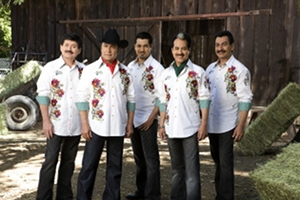
Los Tigres del Norte
Between December 2, 2011 and January 6, 2012 SiriusXM Navidad will be available on channel 501 to subscribers of the satellite music service. Music from Ricky Martin, Gloria Estefan, Thalia, José Feliciano, Aventura, Marco Antonio Solís y Christina Aguilera is planned.

Charlie Zaa, guest DJ, SiriusXM
Guest DJs include Romeo Santos, Charlie Zaa, Thalía and Los Tigres Del Norte. Some of the songs scheduled to air are El Año Viejo, Llegó La Navidad, La Parranda, Rodolfo El Reno De La Nariz Roja, La Temporada es Buena, Feliz Navidad, Aires de Navidad, Navidad Sin Ti, No Hay Cama Pa’ Tanta Gente y El Burrito Sabanero. Navidad is available on Edge and Limited Engagements 3 by SiriusXM Internet Radio channel 813.
Posted by Elena del Valle on December 12, 2011

Photos: YouTube, Hulu, Vevo
In October, 184 million people in the United States spent an average of 21.1 hours per person watching 42.6 billion videos online, the highest number to date, according to comScore Video Metrix data released November 28, 2011.
The top place went to Google Sites and YouTube.com with 161 million unique viewers spending about 7.1 hours per view and 20.9 billion videos viewed. On YouTube, in general, 48 hours of video are uploaded every minute resulting in almost eight years worth of content uploaded daily by 800 million monthly visitors 18 to 54 years old.

YouTube visitors watch three billion videos a day. These estimates are so large because YouTube is available is available in 25 countries and 43 languages and 70 percent of the site’s traffic originates outside the United States.
On a broad scale, YouTube is monetizing 3 billion video views per week globally. According to the company website, 98 of AdAge’s Top 100 advertisers have run campaigns on YouTube and the Google Display Network and the number of advertisers purchasing display ads increased 10 fold in the last year.
Next on the comScore list was Facebook.com with 59.8 million viewers, Vevo with 57 million, Microsoft Sites with 49.1 million and Viacom Digital with 48.2 million.

With videos came video ads. Some 7.5 billion video ads were displayed in October. Hulu generated the highest number of video ad impressions, 1.3 billion. Tremor Video, with more than 1 billion, was second for the first time. Next in descending order were BrightRoll Video Network (756 million), Specific Media (512 million) and CBS Interactive (415 million).
ComScore staff estimate video ads reached 53 percent of the U.S. population an average of 47 times during the month and that viewers spent 3.2 billion minutes watching video ads in October. Tremor Video ads reached the top spot with 614 million minutes. Hulu delivered the highest frequency of video ads to its viewers with an average of 46.5.
Posted by Elena del Valle on December 9, 2011
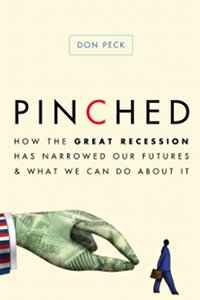
Pinched book cover
Photos:
During the Great Recession of 2009 the economy shrank 4 percent, more than 8 million Americans became unemployed, home values dropped about 30 percent on average, the Dow was roughed up and 165 banks failed just to name some highlights.
Don Peck, features editor at The Atlantic, believes this most recent recession and the technological changes that preceded it will have a lasting impact on our country, specifically on the way we live, our work, and our family ties. Although some businesses and individuals are adapting overall Americans have been unable to adapt; this inflexibility has led to economic weakness and a social divide, according to the writer.
In Pinched How the Great Recession has narrowed our futures and what we can do about it (Crown Publishers, $22), a 223-page hardcover book published this year, he explains his theories and proposes solutions. He is optimistic in the country’s ability to overcome this historically difficult period thanks to its capacity for adaptability and reinvention, he says in the Introduction.

Don Peck, author, Pinched
The writer, a resident of Washington, D.C. who covers the economy and American society, is of the opinion that there is a divide between rich non rich Americans that affects the views and impact of the wealthiest in society; that power urban areas are overcoming the worst of the recession while suburbs and other areas favored by the middle class are falling behind; that because many working class men have lost their jobs women are the new economic leaders of the household; and that the earning power of Millenials is decreasing, affecting that generation’s views and confidence.
“Amid the strains and fissiparous forces of a new, global era, can we still find ways to mix and balance liberty with justice, self-interest with cooperation?” he asks in the final chapter; and closes with the idea that to remain a united country Americans must find a way to do just that.
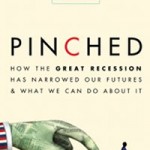
Click to buy Pinched
Comments:
Filed Under: Books
Posted by Elena del Valle on December 7, 2011

Cats were the second most popular pet
Photos: HispanicMPR
Although the percent of households with children (45 percent in 2010) across the country is leveling off and this trend is unlikely to change given the economic situation, homes with children are more likely to have a pet than childless households, according to America’s Pet Owners U.S. September 2011, a Mintel report.
At the same time, some people are acquiring pets in lieu of having children perhaps due to the high cost of child rearing. More than half (54 percent) of respondents to a 2011 online survey of 1,250 pet owners aged 21-30 by Flexcin International said they preferred to have dogs instead of children.
Who owns pets and what kind of pets do they own? Young adults, 18 to 24 years of age, are the most likely to own pets, according to the Mintel survey responses. They may be in search of companionship if they are living alone and these pet owners, researchers believe, are less likely than older pet owners to be aware of the long-term consequences of having a pet. The most common pets were cats, dogs, fish, birds, guinea pig, hamster, ferret, rabbit, snakes and rodents in that order.
Black respondents to the Mintel survey were less likely to own dogs or cats than Hispanics and whites; as residents of densely populated urban areas blacks had less space for pets, according to the Mintel analysis. Many of the Hispanic respondents indicated they lived in a home with a large number of members where space was also limited; this group had a higher ownership of fish and birds than non Hispanics.

Tasha, a chow chow, and her puppies
Mintel researchers believe that since many whites live in suburban or rural areas with ample space to accommodate dogs and cats this group owns cats and dogs in greater numbers than other ethnic and racial groups.
Hispanic respondents to the survey seemed to be most interested in pet friendly accommodations. Black respondents to the survey appeared to be the most likely to hire dog nail trimming, grooming/washing, and teeth cleaning services. At the same time, Hispanic dog owners who participated in the study said they enjoy the fun side of dog ownership, although they appeared less likely to pay close attention to their dog’s health or be willing to make personal sacrifices for their dog.
“Our hispanic (Hispanic) market is very low, only 2%, this is due to the reason that we don’t have this kind of business in our countries, our business is personalized in home pet sitting, so this requierd (required) to owners to give us a key of their house, alarm codes etc. to enter inside the house, hispanic (Hispanic) costumers call us ‘are you crazy? i’m not giving you the key of my house!'” said Oswaldo Cuadros, owner, Pet Sitting at Weston. ” Again hispanic (Hispanic) costumers needs to learn the benefit of professional pet sitters.”
More whites, often living in larger homes, said they have large and extra-large dogs than other groups. Hispanic survey respondents said they favor toy and small dogs. According to a 2009 Mintel survey, 11 percent of Latinos (compared to 6 percent of non Hispanic households with dogs) who own dogs have Chihuahuas (Mintel’s America’s Pet Owners U.S. November 2009).

































